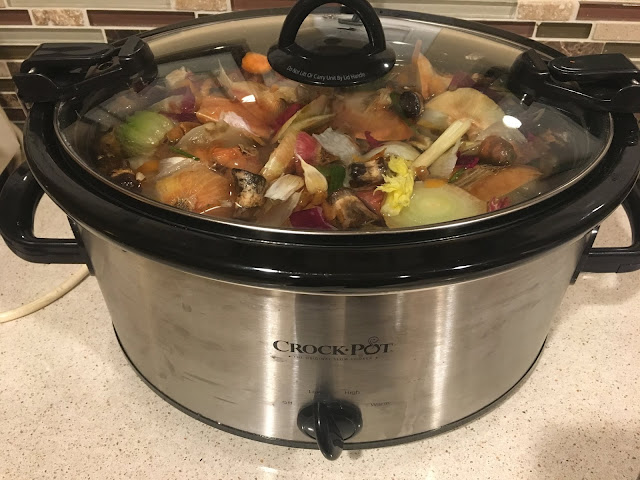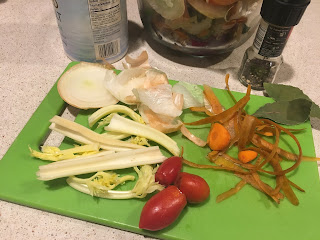
Recipe: No-waste method lets you customize a kitchen staple
 |
| Great broth in the making: Veggie scraps, water and heat. (Photos: Kathy Morrison) |
It’s finally the time of year when I don’t mind heating up the kitchen to make soup, stew or risotto.
I like chicken broth just fine, but prefer to use vegetable stock or broth for these type of dishes. The handy aseptic packages in the grocery store hide a lot of information, however. Is this kind tomato-y or more oniony? How earthy is that broth that has mushrooms listed in the ingredients?
The easy answer to this (no surprise) is to make your own. The recipe below is more method than prescription, as you’ll see.
Since we’re all gardeners or aspiring gardeners here, I’m going to assume you’re already composting your kitchen scraps. Many of those scraps can be used to flavor vegetable broth for several dishes -- and they still can be composted afterwards.
The trick is to use your freezer, and to assess every vegetable bit before it hits the compost bin. Onion tops? Yes. Dried-out garlic cloves? Yes again. Carrot peelings? Absolutely. Other favorites in my house include mushroom stems, celery leaves and ends, limp tomatoes and wilted spinach. I keep them in a gallon freezer bag and add to it over the course of several weeks. Sometimes I have two bags going, for different ingredients.

|
Comments
0 comments have been posted.Sacramento Digs Gardening to your inbox.
Sites We Like
Garden Checklist for week of July 21
Your garden needs you!
* Keep your vegetable garden watered, mulched and weeded. Water before 8 a.m. to reduce the chance of fungal infection and to conserve moisture.
* Feed vegetable plants bone meal, rock phosphate or other fertilizers high in phosphate to stimulate more blooms and fruiting. (But wait until daily high temperatures drop out of the 100s.)
* Don’t let tomatoes wilt or dry out completely. Give tomatoes a deep watering two to three times a week.
* Harvest vegetables promptly to encourage plants to produce more. Squash especially tends to grow rapidly in hot weather. Keep an eye on zucchini.
* Pinch back chrysanthemums for bushy plants and more flowers in September.
* Remove spent flowers from roses, daylilies and other bloomers as they finish flowering.
* Pinch off blooms from basil so the plant will grow more leaves.
* Cut back lavender after flowering to promote a second bloom.
* It's not too late to add a splash of color. Plant petunias, snapdragons, zinnias and marigolds.
* From seed, plant corn, pumpkins, radishes, winter squash and sunflowers.